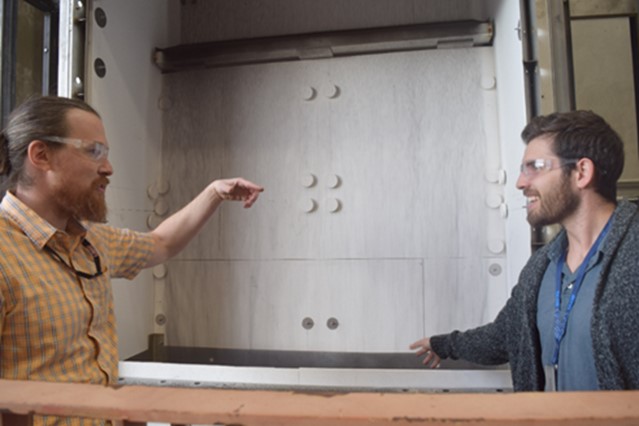
Scientists at Sandia’s National Solar Thermal Test Facility have successfully tested a new falling-particle receiver that will operate within the Generation 3 Particle Pilot Plant currently under construction. Operating at up to 2 megawatts of concentrated radiative energy, the receiver is double the size of the facility’s previous falling-particle receiver and represents a major step toward the commercial scalability of particle-based concentrating solar power, as well as a key milestone for the G3P3 project.
“Successfully completing this test campaign was a critical step on the road to demonstrating a fully integrated, particle-based concentrating solar power facility,” said Brantley Mills, acting principal investigator on the G3P3 project. “It allowed us to derisk a key system in the loop and confirm important performance metrics ahead of installation in the tower. Until now, these metrics had been demonstrated using numerical models only.”
Testing the receiver prior to installation
In the spring of 2021, the DOE announced a Phase III, $25 million award to Sandia to build, test and demonstrate a next-generation concentrating solar thermal power plant at the National Solar Thermal Test Facility. The award is part of a $70 million multiyear DOE Generation 3 CSP Systems program that began in 2018. Sandia broke ground on the Gen 3 CSP power plant in February 2023.

(Photo by Anthony Evans)
The receiver system is a critical component of a particle-based concentrating solar power system that raises the temperature of a particle stream up to 800 degrees Celsius by flowing it past a beam of concentrated sunlight. Ultimately, those particles are then used to heat a high-efficiency supercritical carbon dioxide loop to generate electricity.
Rather than wait until the tower’s completion to move particles through the receiver, a test campaign was executed on the ground by flowing batches of particles through the receiver cavity at anticipated flow rates. As the particles fell through the cavity, control and data acquisition systems could be properly evaluated. Additionally, the path that particles fall in the cavity and mass flow rate uniformity, which are essential to the receiver’s performance and efficiency, could be evaluated.
By evaluating these key metrics on the ground, modifications could be made to the system before it was installed in the tower, reducing costs and accelerating the schedule.
Promising particle curtain behavior
The tests demonstrated that many of the key design features integrated into the receiver, which were incorporated after learning lessons from previous prototypes, showed promising particle curtain behavior in line with expectations. These features include a cavity shape that minimizes thermal losses and catch-and-release particle obstructions. This metal trough — which catches particles and then overfills on the leading edge — was designed to increase particle residence time and improve curtain uniformity.
Although final confirmation will occur on the completed tower, observations from these tests provide confidence that particles can be delivered at necessary temperatures to generate electricity. These tests also show that the control and data acquisition systems were successfully integrated with the receiver hardware to precisely vary the particle flow rates.
Envisioning the future
Moving forward, the G3P3 team will make final modifications to the receiver hardware and controls. Once it is in its final position, the receiver will be integrated into the rest of the G3P3 system.
When the full system is complete, the concentrated sunlight from the National Solar Thermal Test Facility heliostat field will be pointed to the receiver to begin delivering hot particles to the G3P3 system.
“Ultimately, we hope that this tower will demonstrate that particle-based CSP plants like this one can be a critical technology in helping the country achieve a fully decarbonized energy grid,” Brantley said.
Additional resources
Read more about Sandia’s Concentrating Solar Power program and the development of the G3P3 project.